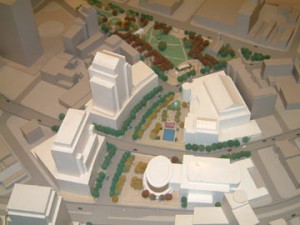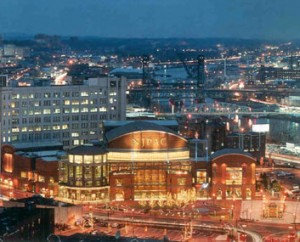New Jersey Performing Arts Center
Winner: New Jersey Performing Arts Center
To the New Jersey Performing Arts Center for lasting positive impact on downtown Newark through its high-quality urban design.
New Jersey Performing Arts Center, with its unwavering commitment to context-sensitive, high-quality urban design has succeeded in one of its primary goals: the transformation of downtown Newark.
The New Jersey Performing Arts Center (NJPAC) made its debut six years ago, opening its doors to great fanfare and acclaim. Since that time, more than 3 million people have visited NJPAC – to see the world’s greatest performers and New Jersey’s top talent; to attend one of hundreds of special events; or to participate in the Arts Center’s nationally recognized Arts Education program.
The New Jersey Performing Arts Center was designed to be more than a top-notch cultural facility, however. From the start, its founders put the revitalization of Newark squarely as part of its mission statement. Early on, the Board of Directors hired experienced urban planners Skidmore, Owings & Merrill and James Stewart Polshek & Partners, to develop a plan for the entire downtown – including NJPAC’s 12 acres – that would maximize the project’s impact on the area. The idea was to create a facility that was “not just in Newark, but of Newark” – literally one step off the street, rather than at arms length from the city.
Following this intense site-planning effort was the selection of Los Angeles-based architect Barton Myers in 1990 to design Phase One of the Arts Center. The New Jersey firm, Wilson Woodridge Associates, was selected as associate architect. Internationally known for his expertise in urbanism and his skill in designing performing arts facilities, Myers was charged with designing a facility that would invite people in and encourage people to come out of the nearby covered walkways and back onto the street. The result: an approachable, human-scale building with graceful features, made of high-quality materials, exquisite lighting and a plaza that would prove to be a magnet for foot traffic in this previously vacant corner of the city.
The emphasis on the pedestrian experience and the revitalization of street life in the downtown is at the core of the NJPAC’s philosophy. During the course of renovating the Military Park garage across the street, there was pressure to create an underground tunnel to link it to the Arts Center. It was commonly thought that people would not be willing to go outside in Newark at night. The Board of Directors, committed to a different vision for the downtown and interested in an “electric arrival experience” for its patrons, did not bow to the pressure and maintained a street entrance to the building.
This sustained commitment to its vision of a revitalized Newark, and to the highest standards in consultants, designers and business practices, are in large part responsible for the facility’s success. NJPAC, from the onset, was able to build a strong relationship with the Mayor and City Council, because it was clear that the best interests of the city are always at the forefront of the Art Center’s decision-making. This public/private partnership with local government has enabled NJPAC to move through the city’s approvals process smoothly, with a project that had the support of the residents of Newark.
The Arts Center has succeeded in breaking a very important barrier – people’s negative expectations of Newark. Prior to its construction, both city residents and New Jerseyans alike never thought a world-class cultural institution could succeed in the downtown. Six years later, NJPAC has proven them wrong. Since it opened, NJPAC has become one of the most well-attended performing arts centers of its kind in the United States. Surveys have shown that 74 percent of New Jerseyans have a better impression of Newark, and 77 percent of Newark residents feel better about their city, since the Arts Center opened.
Not only has there been a positive psychological impact resulting from the new Arts Center, there has also been a positive reaction from the private sector as well. NJPAC is credited for much of the recent reinvestment that is currently taking place in downtown Newark. During the past six years, new restaurants have opened their doors, property owners have begun renovating buildings in the area, and more corporations and professionals have moved in. According to National Redevelopment Real Estate, in 1997, office buildings in Newark’s downtown were only 20 percent occupied and by 2001 they were at 80 percent.
The Arts Center also has elevated the conversations about the future of downtown Newark, as shown in the recent planning efforts underway for the Passaic Riverfront. Rather than “taking what it can get” when it comes to new development, Newark has begun to ask questions about public access and the pedestrian experience, show concern for mixed-use versus single-use, and has also begun to develop design standards for new buildings in the downtown. The newly completed 12-story FBI building adjacent to the Arts Center reflects this influence in that it was not built in the fortress-fashion that was once so common to Newark. Instead, it was designed to be more open to the street with a mix of uses, including restaurants and retail.
The role of the Arts Center in revitalizing downtown Newark is far from over. Its vision, as described in its Master Plan, calls for the development of a mixed-use theatre district on its remaining parcels of land. Large open plazas surrounded by new retail, cafes and restaurants as well as market-rate housing are all on the discussion table. As a property owner with Newark’s revitalization as part of its own mission, NJPAC will continue to be a vocal advocate for high-quality urban design with an emphasis on public access to the City’s amenities, including Passaic Riverfront.
Images courtesy of the New Jersey Performing Arts Center













